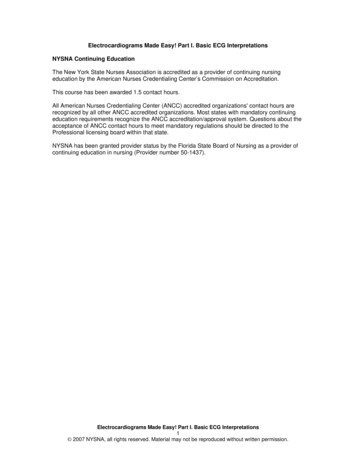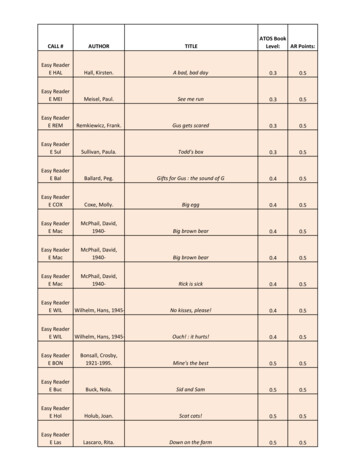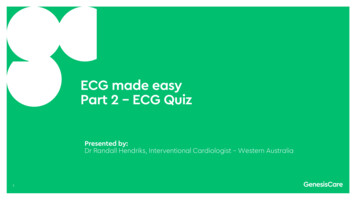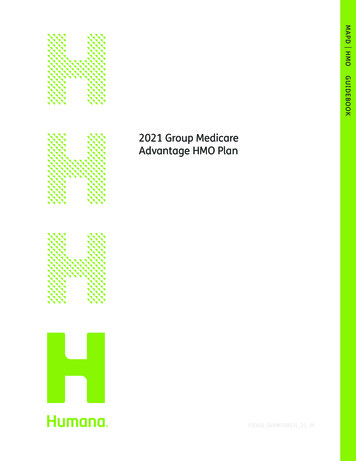
Transcription
Electrocardiograms Made Easy! Part I. Basic EKG InterpretationsNYSNA Continuing EducationThe New York State Nurses Association is accredited as a provider of continuing nursing education by theAmerican Nurses Credentialing Center’s Commission on Accreditation.This course has been awarded 1.5 contact hours.All American Nurses Credentialing Center (ANCC) accredited organizations' contact hours are recognized byall other ANCC accredited organizations. Most states with mandatory continuing education requirementsrecognize the ANCC accreditation/approval system. Questions about the acceptance of ANCC contact hoursto meet mandatory regulations should be directed to the Professional licensing board within that state.NYSNA has been granted provider status by the Florida State Board of Nursing as a provider of continuingeducation in nursing (Provider number 50-1437).Electrocardiograms Made Easy! Part I. Basic EKG Interpretations1 2008 NYSNA, all rights reserved. Material may not be reproduced without written permission.
How to Take This CoursePlease take a look at the steps below; these will help you to progress through the course material, completethe course examination and receive your certificate of completion.1. REVIEW THE OBJECTIVESThe objectives provide an overview of the entire course and identify what information will be focusedon. Objectives are stated in terms of what you, the learner, will know or be able to do uponsuccessful completion of the course. They let you know what you should expect to learn by taking aparticular course and can help focus your study.2. STUDY EACH SECTION IN ORDERKeep your learning "programmed" by reviewing the materials in order. This will help you understandthe sections that follow.3. COMPLETE THE COURSE EXAMAfter studying the course, click on the "Course Exam" option located on the course navigationtoolbar. Answer each question by clicking on the button corresponding to the correct answer. Allquestions must be answered before the test can be graded; there is only one correct answer perquestion. You may refer back to the course material by minimizing the course exam window.4. GRADE THE TESTNext, click on "Submit Test." You will know immediately whether you passed or failed. If you do notsuccessfully complete the exam on the first attempt, you may take the exam again. If you do notpass the exam on your second attempt, you will need to purchase the course again.5. FILL OUT THE EVALUATION FORMUpon passing the course exam you will be prompted to complete a course evaluation. You will haveaccess to the certificate of completion after you complete the evaluation. At this point, you shouldprint the certificate and keep it for your records.Electrocardiograms Made Easy! Part I. Basic EKG Interpretations2 2008 NYSNA, all rights reserved. Material may not be reproduced without written permission.
IntroductionElectrocardiograms Made Easy! is a series of three courses comprised of: Basic EKG Interpretations,Interpreting Abnormal Atrial Rhythms, and Interpreting Ventricular Dysrhythmias.The aim of Part I. Basic EKG Interpretations (the first course in the series) is to advance the learners’understanding of the electrocardiogram and develop their skills at reading a basic electrocardiogram rhythmstrip. In a cardiac emergency being able to identify the precipitating event is half the battle, a battle in which“time is muscle.”As the song by Cruel Sea states, “the heart is a muscle and it pumps blood, like a big old black steam train.”If its function were as simplistic as this, then there would be no need to read on. However this is not thecase and there have been a lot of advances in the way we think about and assess the functioning of theheart. If you listen to an orthopedic surgeon, the heart’s main purpose is to pump antibiotics around thebody. Depending on your position in the healthcare environment, your idea of the heart’s function may besimilar. But for nurses, the heart and its associated problems is one of the most common ailments afflictingthose for whom we care.Cardiovascular disease is composed of heart disease and cerebrovascular accidents (strokes).Respectively, they are the leading and third leading cause of death in the United States. Together theyaccount for the death of 950,000 Americans each year (Centers for Disease Control and Prevention [CDC],n.d.). More broadly, 61 million Americans (almost one in four) suffer from some form of cardiovasculardisease (CDC, n.d.). With tightening purse strings, the impact of cardiovascular diseases on healthcareresources is astounding. The Center for Disease Control and Prevention (CDC) estimates that in 2003 thecost of cardiovascular disease to the economy was 351 billion (CDC, n.d.). So what does this mean toyou?As active participants in health care you will undoubtedly come in contact with the one in four Americans whohave cardiovascular disease. This contact may be in any setting: from an emergency department, surgicalward, rehabilitation, or your own family home. So it is important to be familiar with and understand the basicsof one of the easiest, most cost-effective, non-invasive tests performed to assess cardiac function: theelectrocardiogram (EKG). It is important to be able to interpret electrocardiograms in order for the skilledregistered nurse to initiate timely interventions.This course will discuss the basics of the electrocardiogram, introduce an easy to remember method forrhythm analysis and build confidence in undertaking and interpreting the basic rhythm strip. There is anemphasis on not letting the reader be “bogged down” with technical jargon and instead focus on identifyingwhat is “normal” in an electrocardiogram rhythm.Content Outline BackgroundElectrical PhysiologyRecording Electrical Impulses (The technical stuff)o The “How To” Perform an EKGUnderstanding Wave MorphologyThe Significance of Wave RecordingInterpreting a Basic Rhythm StripSummary and Practice ExamplesElectrocardiograms Made Easy! Part I. Basic EKG Interpretations3 2008 NYSNA, all rights reserved. Material may not be reproduced without written permission.
Course ObjectivesUpon the completion of this course the learner will be able to: Describe the electrical physiology of the heart.Identify current electrode placement for performance of a 12 lead electrocardiogram.Identify the five characteristics used to determine a cardiac rhythm.Recognize the characteristics of normal sinus rhythm.Electrocardiograms Made Easy! Part I. Basic EKG Interpretations4 2008 NYSNA, all rights reserved. Material may not be reproduced without written permission.
About the AuthorDavid Pickham, MN, RN, began his nursing education at the University of Newcastle in New South Wales,Australia. He has since worked as a registered nurse focusing on emergency medicine in Australia, Canada,and the United States. He has a master’s of nursing in advanced practice and currently is a doctoralcandidate at the University of California. His interests lie specifically in the field of electrocardiography (alsoknown as ECG or EKG) which led him to create courses on Electrocardiograms Made Easy!This course was updated in August 2008 by Sally Dreslin, MA, RN, CEN. Ms Dreslin is an AssociateDirector in the Education, Practice and Research Program of the New York State Nurses Association.Electrocardiograms Made Easy! Part I. Basic EKG Interpretations5 2008 NYSNA, all rights reserved. Material may not be reproduced without written permission.
BackgroundWillem Einthoven, a Dutch physiologist, was responsible for developing the technique of recording theelectrical activity of the heart (Bullock, Boyle, & Wang, 2001). Later winning a Nobel Prize for his efforts, theelectrocardiogram (EKG) has since become the mainstay in the initial assessment of cardiac function.Importantly the EKG will not measure the heart’s mechanical action; instead the EKG records the electricalactivity responsible for cardiac function. Understanding the relationship between the mechanical/electricalsystems within the heart will help conceptualize the EKG.Figure 1. “An Early EKG” Courtesy of: Stichting Einthoven/Einthoven Foundation, the NetherlandsElectrocardiograms Made Easy! Part I. Basic EKG Interpretations6 2008 NYSNA, all rights reserved. Material may not be reproduced without written permission.
Electrical PhysiologyCardiac cells are physiologically unique within the body. These cells have the capability to initiate electricalactivity (automaticity), respond to electrical activity (excitability), relay an impulse (conductivity), and reactphysically to a stimulus (contractility). The importance of these characteristics in cardiac functioning will beevident throughout.For the heart to perform a beat, a signal must be sent through the heart telling its muscle to work (contract).This “signal” originates in the right atrium in a specialized group of cells termed the SA node (sino-atrialnode). The SA node propagates a signal approximately 60-100 times per minute (Newberry, 2003). Thissignal or impulse moves from the SA node to the atria and AV node (atrio-ventricular node) through “signalhighways” in the atria (intra-atrial tracts). During this time atrial contraction occurs. Once at the AV node thesignal is delayed or “held-up” for a fraction of time, before it is allowed to progress. This slight delay allowsthe atria to finish contraction before ventricular involvement.After a small delay the impulse travels from the AV node to the ventricles through another specializedhighway located in the septum of the ventricles. This highway is called the Bundle of His. The Bundle of Hisbranches into the left and right bundle branches, and each delivers the impulse to their respective ventricles.Once in either ventricle these branches continue to form smaller branches (much like a river stream) calledPurkinje fibers. These smaller branches (Purkinje) deliver the impulse to the rest of the ventricle musclewhereby contraction occurs. The delivery of an impulse occurs simultaneously down the left and rightventricle. Refer to Figure 2 for a visual illustration.Figure 2. “Conduction System Pathway” Courtesy of: University of OtagoIn Summary:Electrocardiograms Made Easy! Part I. Basic EKG Interpretations7 2008 NYSNA, all rights reserved. Material may not be reproduced without written permission.
Electrocardiograms Made Easy! Part I. Basic EKG Interpretations8 2008 NYSNA, all rights reserved. Material may not be reproduced without written permission.
Recording Electrical Impulses (The technical stuff)In earlier periods an EKG was performed by placing a patient’s arms and legs into wired buckets filled withan electrolyte solution (Lilly, 2002) and recording the voltage difference (See Figure 1 “An Early EKG” in theBackground section). We have since advanced on this method considerably. Today we perform an EKG byplacing ten electrodes in a pre-determined pattern on the patient’s skin. These electrodes are then used bya galvanometer (a fancy sounding device used to measure low voltage currents) to record the voltagedifference between any two electrodes. With a goal of decreasing the learner’s anxiety of EKG performanceand interpretation, the exact science behind action potentials and measurement will not be discussed.Knowledge of this is not pertinent to interpreting the basic EKG.The “How To” Perform an EKGDon’t be misled by the term 12 lead EKG. As stated above, an EKG requires the placement of ten leads (orelectrodes). Simply stated, the galvanometer uses the ten leads to make twelve different recordings.Depending on the type of EKG needed, the leads are placed in a specific location. The following is the basiclocations for a 12 lead EKG: 4 limb leadso Right Arm (RA), Left Arm (LA)o Right Leg (RL), Left Leg (LL) 6 precordial (chest) leads (see Figure 3)o V1 - 4th intercostals space, right sternal bordero V2 - 4th intercostals space, left sternal bordero V3 - In between V2 and V4 (5th intercostals border)o V4 - 5th intercostals space, midclavicular lineo V5 - 5th intercostals space, anterior axillary lineo V6 - 5th intercostals space, midaxillary lineFigure 3. “Chest Lead Location” Courtesy of: EMS Solutions (http://ems-safety.com)Note: Each lead is recording a snapshot of the electrical activity within the heart at a given time, from itsperspective.Not So Difficult Right? Now, Understanding What Has HappenedElectrocardiograms Made Easy! Part I. Basic EKG Interpretations9 2008 NYSNA, all rights reserved. Material may not be reproduced without written permission.
By now you have a basic understanding of the electrical system of the heart and the technique for performingan EKG.Depending on the brand of EKG that your organization uses, your printout page will basically have a lot ofdiffering lines each with a separate heading. Each one of these lines represents a different view of thecardiac function. At this stage we are ONLY interested with the line that says II (lead 2). Often this is printedon the bottom of the page and again on the left hand side.When we look at wave morphology (Figure 4) we can see three distinctive waves or deflections. Revert backto the electrical physiology skills and we will review these in context. Note the labeling of these threedeflections as the P wave, QRS complex, and the T wave. Don’t worry about anything else at this stage, itisn’t important.What do these represent? Thinking back, the SA node produces an impulse that travels through intra-atrialpathways to the AV node, causing atrial contraction. This is shown by the P wave (referred to asdepolarization of the atria). If you notice it moves from a straight line (baseline) to a small wave and thenback to baseline. The return to baseline represents the small delay experienced at the AV node. After theimpulse is received from the atria, the atria can relax and regroup. During this time the impulse travels to theventricles via the Bundle of His and the Purkinje fibers. This action contracts the strong ventricles and isrepresented by the larger QRS complex (group of waves deemed Q, R, and S), representing the time thedepolarization takes to spread through the ventricles (don’t worry about the individual letters at this stage,just keep in mind QRS ventricular depolarization). After a small delay, regrouping of the ventricles(repolarization) is represented by the T wave. The wave is much bigger when the ventricles contract, as theventricles are markedly larger then the atria.Figure 4. “Basic EKG Morphology” Courtesy of: University of Utah School of MedicineIn the normal cardiac cycle the P wave must be followed closely by the QRS complex and likewise eachQRS complex must be preceded by a P wave. As we now know, this will mean that the stimulus for aheartbeat has originated in the atria (P wave) and then excited the ventricles (QRS wave). Think of themechanics of a normal heartbeat: the atria will contract and then the ventricles.Question: I now know what these waves and intervals represent, but why do the waves look different in eachlead?Electrocardiograms Made Easy! Part I. Basic EKG Interpretations10 2008 NYSNA, all rights reserved. Material may not be reproduced without written permission.
Don’t worry, it all means the same thing but is represented differently depending on each leads’ viewpoint.Imagine if you will that you and two friends are watching a float drive by and you are all in different viewingpositions. Each person will have a unique view, one viewing side-on, one viewing head-on, and anotherviewing the other side. No two views look the same despite seeing the same event. This is what isoccurring on an EKG. Look at Figure 5 which represents the precordial (chest) leads. See how thewaveform is recorded in the differing views. Don’t get caught up on this! Accept that each lead has adifferent view of the same event and move on.Figure 5. “Precordial lead waveforms” Used with permission from eMedicine.com, Inc., 2007Do you have a thirst for knowledge?In the resting state the myocardial cell surface has a positive charge compared to the negative charge insidethe cell, hence the EKG reading is baseline as both equal and opposite charges cancel each other out.When initially stimulated, the area outside the cell will shift to negative and shift inside to positive. This shiftcauses an electrical force (depolarization wave) that can be recorded as it travels throughout conductingcells of the heart, changing the surface charge and contracting. The different leads record this wavedissimilarly depending on their location and electrode charge.Electrocardiograms Made Easy! Part I. Basic EKG Interpretations11 2008 NYSNA, all rights reserved. Material may not be reproduced without written permission.
The Significance of Wave RecordingWe have performed an EKG and recorded the electrical characteristics of the heartbeat. Is there anythingelse we can learn from this wave morphology? YES. But first we need to understand why we use the paperwe use.EKG paper is special, as its use allows us to calculate the time in various sequences of the cardiac cycle.We know (as it is recorded on the top of the paper) that EKG paper advances 25mm/second (that’s five largeboxes each second). Deducting from that, one large box (comprised of five smaller boxes) is equal to onefifth of a second or 0.20 seconds. STAY WITH ME ON THIS. There are five smaller boxes in one big box,therefore equaling one fifth of 0.20 seconds, or 0.04 seconds. See Figure 6.Figure 6. “Grid sizing”RECAP:Large box 0.20 seconds. Small box 0.04 seconds.Who cares? We do, read on!!If you look again at Figure 4, you will notice there are brackets between the wave deflections. Thesebrackets are intervals that can be timed and compared to normal cardiac functioning. Labeled, thesebrackets are the PR interval, QRS interval, and the QT interval. Each interval represents a mechanicalfunction and has a set time for what is considered “normal functioning,” beyond these times functioning maybe considered abnormal. At this stage in the EKG learning, just be able to understand what is considerednormal (you will need to learn these distances). See Figure 7. PR interval (Onset of P wave to onset of QRS).o Time between onset of atrial depolarization and ventricular depolarization.o 0.12-0.20 seconds (3-5 small boxes). QRS interval (Beginning to end of the QRS).o Duration of ventricular depolarization.o Less then 0.12 seconds (3 small boxes).QT interval (Beginning of QRS to end of T wave).o Beginning of ventricular depolarization to end of ventricular repolarization.o Generally no more then 0.40 seconds (10 small boxes). Electrocardiograms Made Easy! Part I. Basic EKG Interpretations12 2008 NYSNA, all rights reserved. Material may not be reproduced without written permission.
Figure 7. “Intervals relative to pathway”Courtesy of: Stichting Einthoven/Einthoven Foundation, the NetherlandsElectrocardiograms Made Easy! Part I. Basic EKG Interpretations13 2008 NYSNA, all rights reserved. Material may not be reproduced without written permission.
Interpreting a Basic Rhythm StripSo far we have covered the history behind the EKG, basic electrophysiology, lead placement, and thesignificance of EKG paper, waveform and intervals as well as their association to the mechanical aspects ofcardiac function. Now it is time to move on to determining the basics of EKG reading.It is easy to cheat while reading EKG’s. We are all aware that the computer gives us a nice read-out of thecharacteristics of the EKG. Up in the top left corner it will spell out everything it can about the EKG. So whydo we need to bother to read it?Like all computers, the EKG is dumb! That’s right I said it. It has been known to be wrong. You see an EKGis just one element of a larger clinical picture. Therefore an EKG needs to be interpreted in context with thepatient’s condition. Don’t be lazy and depend on the EKG for information about the patient’s cardiacfunction. There are five simple characteristics we need to identify to successfully read a rhythm strip. Let’sgo through them one by one.1. RateThe first step in reading an EKG is to determine the rate. Like all things in life there is more then onemethod. Remember back to the wave morphology where the QRS represents ventricular depolarization.This is the period when blood is ejected out of the ventricles into the pulmonary and systemic systems.Calculating the number of times this ejection occurs per minute is the heart rate.The first method involves counting these heartbeats off the EKG paper. To achieve this, count and mark sixseconds on the paper (five large boxes 1 second, therefore 6 seconds 30 large boxes). Now count thenumber of QRS complexes in six seconds and multiply by ten (6 seconds x 10 1 minute). See Figure 8.Figure 8.Done! You can now correctly determine the rate from an EKG. Congratulations. Do you want to know amore efficient way?The second method is much quicker. Look at the paper and try to align the R point of the QRS, with a darkerline. Now count off each large box with fixed numbers, until you reach the next QRS complex. Thesenumbers are (hint: memorizes these) 300 for the 1st box, 2nd 150, 3rd 100, 4th 75, 5th 60, 6th 50, 7th 43, and soon. This will give you an approximate heart rate. If there are four boxes between the two R waves (QRScomplexes) this means the heart rate is 75 beats/minute. Look at Figure 9 and see if you can figure the rate.Figure 9.Electrocardiograms Made Easy! Part I. Basic EKG Interpretations14 2008 NYSNA, all rights reserved. Material may not be reproduced without written permission.
That’s right around 100 beats/minute (remember it’s an approximate).2. RhythmNow that we can figure out the rate, what we want to check next is whether the heartbeats are regular orirregular. This is important as it can help us identify certain dysrhythmias later on. To assess whether theheart is beating regularly or irregularly we need to “map out” the R and P waves. There are two ways thatthis can be done. One way is to count the number of boxes between one R wave and the next. Thencompare this distance to the next and adjacent R waves. Once the consistency of the R wave is established,map out the P waves. Are the distances between R waves equal? What about the P waves?WANT THE EASY WAY OUT?Grab a pen and paper. Place this on top of the EKG readout leaving exposed the R waves. Now make aline corresponding with an R wave, repeat these 3 times. See Figure 10a.Figure 10a.Now move the paper along the rhythm strip comparing the R distances. See Figure 10b.Figure 10 b.Electrocardiograms Made Easy! Part I. Basic EKG Interpretations15 2008 NYSNA, all rights reserved. Material may not be reproduced without written permission.
Do the same for the P wave. See Figures 10c and 10d.Figure 10c.Figure 10d.See how the distances between the R waves and the distances between the P waves map out with eachother. We can now call this rhythm “regular.” At this stage of the game we are only concerned with therhythm’s rate and whether it is regular or irregular. What is the rhythm rate in Figure 10d? Go back if youneed to.If you answered 75 you are correct, well done. Now we know that the rhythm is regular with a rate of 75beats per minute. Too easy!3. & 4. Now Let’s Examine the P WaveAt this stage it is important to identify the presence of a P wave. If it is present we then check if the PRinterval is within normal limits (look at Figure 11 for a guide). Can you identify the distance of the PR intervalin Figure 12 in the following section?Figure 11.If you said around four small boxes, then once again you are right.Now importantly, compare the PR interval in each beat. Use themapping technique to determine the rhythm regularity. Is thisdistance that we have identified the same in each beat? If so, westate that the PR interval is fixed. If it wasn’t we say that the PRinterval is varied.5. The QRSElectrocardiograms Made Easy! Part I. Basic EKG Interpretations16 2008 NYSNA, all rights reserved. Material may not be reproduced without written permission.
Now that you have the rate, we know it is regular and you have the presence of a P wave with a fixed PRinterval. It is time to see if the QRS is within normal limits. Do you remember the normal limits? Below isa summary. (You need to remember these!)CharacteristicPR intervalQRS complexQT intervalNormal limits0.12-0.20 seconds (3-5 small boxes)0.04-0.12 seconds (1-3 small boxes)Less than 0.40 seconds (10 small boxes)When considering the QRS complex we know that it should be three small boxes or less, from beginningto end (use Figure 13 as a guide). Look at Figure 12 below and see if you can count it.Figure 12.Figure 13.If the QRS complex measures three boxes(0.12 seconds) or less, we term this narrow.If it is greater than three boxes we label thiswide. The significance of this will be evidentlater on, for now just be able to identifywhether the QRS is narrow or wide. Is theQRS in Figure 12 narrow or wide?If you said narrow then you’re doing well, remember EKG’s take practice and you’ll get it, but for now justkeep up.Electrocardiograms Made Easy! Part I. Basic EKG Interpretations17 2008 NYSNA, all rights reserved. Material may not be reproduced without written permission.
Sum it All Up Maestro!Every time you are given a rhythm to interpret, go through these important five questions. These will helpidentify the rhythm.By now you can confidently establish these five steps by yourself.1.2.3.4.5.What is the determined rate?Is the rhythm regular or irregular?Is the P wave present?Is the PR interval fixed or varied?Is the QRS wide or narrow?If you can look at a rhythm and answer these questions you will identify whether the EKG is normal orabnormal, that is the battle. If you are confident about what a normal EKG looks like, then you will easily andquickly recognize an abnormal EKG.Remember, if the EKG consists of a regular rhythm rate between 60 and 100 (sinus) and you can identifyupright P waves that have a fixed PR interval, followed closely by a narrow QRS complex, then you arelooking at an EKG that is consistent with normal cardiac function. You have successfully identified the firstrhythm, Normal Sinus Rhythm. If, however, any of these differed from normal wave morphology then youhave identified a dysrhythmia. For interpretation of dysrhythmias please refer to these two additionalcourses, Electrocardiograms Made Easy! Part II. Interpreting Abnormal Atrial Rhythms andElectrocardiograms Made Easy! Part III Interpreting Ventricular Dysrhythmias. Before then however,work through these five examples.Example 1.Rate:Regular or Irregular:P present: Y or NPR Fixed or varied QRS Narrow or wide:What is the rhythm?Electrocardiograms Made Easy! Part I. Basic EKG Interpretations18 2008 NYSNA, all rights reserved. Material may not be reproduced without written permission.
Example 2.Rate:Regular or Irregular:P present: Y or NPR Fixed or varied QRS Narrow or wide:What is the rhythm?Example 3.Rate:Regular or Irregular:P present: Y or NPR Fixed or varied QRS Narrow or wide:What is the rhythm?Example 4.Rate:Regular or Irregular:P present: Y or NPR Fixed or varied QRS Narrow or wide:What is the rhythm?Electrocardiograms Made Easy! Part I. Basic EKG Interpretations19 2008 NYSNA, all rights reserved. Material may not be reproduced without written permission.
Example 5.Rate:Regular or Irregular:P present: Y or NPR Fixed or varied QRS Narrow or wide:What is the rhythm?Please turn to page 21 for the answers to these practice examples.Hopefully you were able to answer the five questions, and correctly identified these strips as normal sinusrhythm. Now that you can identify a normal EKG, you’re ready to take the next course in this series:Electrocardiograms Made Easy! Part II. Interpreting Abnormal Atrial Rhythms. Here you will beintroduced to abnormal EKG’s, where you will learn how to identify and interpret many commondysrhythmias.Electrocardiograms Made Easy! Part I. Basic EKG Interpretations20 2008 NYSNA, all rights reserved. Material may not be reproduced without written permission.
Answers to Practice ExamplesExample 1:Rate: 52Regular or irregular: RegularP present: YesPR fixed or varied: FixedQRS narrow or wide: NarrowRhythm: Normal sinus rhythm (NSR)Example 2:Rate: 75Regular or irregular: RegularP present: YesPR fixed or varied: VariedQRS narrow or wide: NarrowRhythm: Normal sinus rhythm (NSR)Example 3:Rate: 64Regular or irregular: RegularP present: YesPR fixed or varied: FixedQRS narrow or wide: NarrowRhythm: Normal sinus rhythm (NSR)Example 4:Rate: 90Regular or irregular: RegularP present: YesPR fixed or varied: FixedQRS narrow or wide: NarrowRhythm: Normal sinus rhythm (NSR)Example 5:Rate: 64Regular or irregular: RegularP present: YesPR fixed or varied: FixedQRS narrow or wide: NarrowRhythm: Normal sinus rhythm (NSR)Electrocardiograms Made Easy! Part I. Basic EKG Interpretations21 2008 NYSNA, all rights reserved. Material may not be reproduced without written permission.
References12 Lead EKG. (2007). Retrieved from http://www.ems-safety.com/12-lead-ekg.htmBullock, J., Boyle, J., & Wang, M. B. (2001). Physiology (4th ed.). Philadelphia, PA: Lippincott Williams &Wilkins.Centers for Disease Control and Prevention. (n.d.). Preventing heart disease and stroke. Retrieved eets/Prevention/dhdsp.htmElectrocardiogram (ECG). (n.d.). Retrieved am ecg/article em.htmEmergency Nurses Association, & Newberry, L. (Ed.). (2002). Sheehy’s emergency nursing: Principles andpractice (5th ed.). St. Louis, MO: Elsevier Health Sciences Division.Lilly, L. S. (Ed.). (2003). Pathophysiology of heart disease. A collaboration project of m
Electrocardiograms Made Easy! is a series of three courses comprised of: Basic EKG Interpretations, Interpreting Abnormal Atrial Rhythms, and Interpreting Ventricular Dysrhythmias. . known as ECG or EKG) which led him to create courses on Electrocardiograms Made Easy! This course was updated in August 2008 by Sally Dreslin, MA, RN, CEN. Ms .










